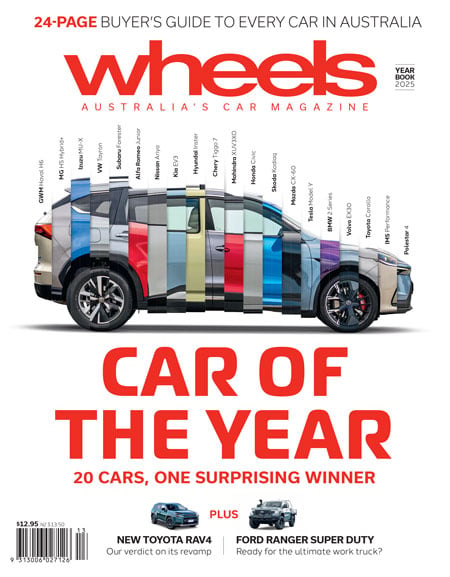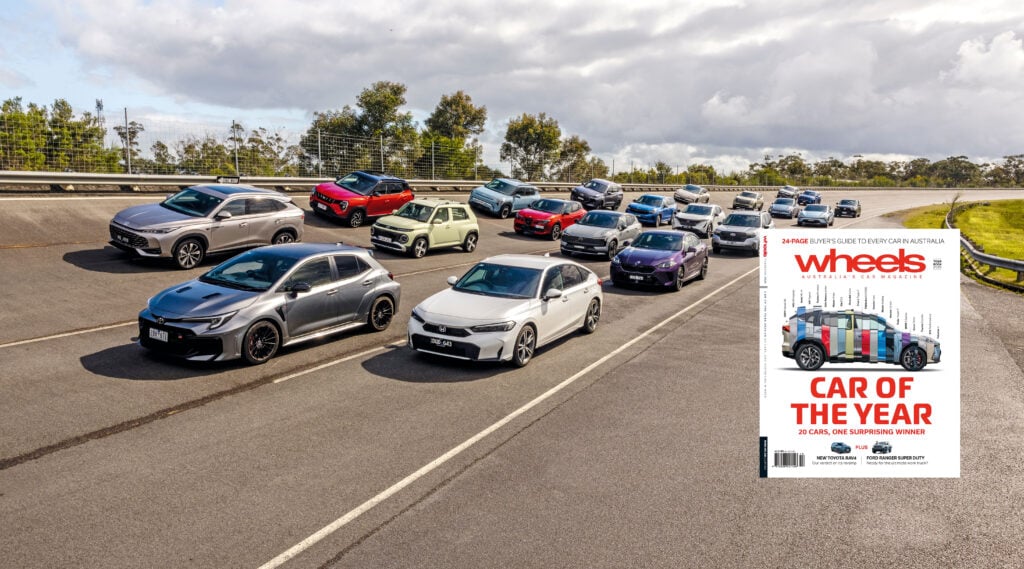DO YOU remember Romsey Quints?
If you do, there’s a fair chance you also know that Bill Tuckey was his creator, handler and spokesman.
Quints was colourful, cantankerous and completely content to raise hell and shine a spotlight on the strange and wonderful stories in the world of motoring and motor racing.
It’s the same for Tuckey, who was everything from a Bathurst racer and the man who tagged Ian Geoghegan as ‘Black Pete’ to a magazine editor, prolific book writer, newspaper reporter, television presenter and talkback radio star.
If you believe Tuckey, and many did, he was on track to win the Bathurst 500 until his co-driver Sib Petralia destroyed the engine in their Holden Monaro 350. Tuckey also claims credit for baptising Allan Grice at Mount Panorama when the pair shared a Fiat 124.
All of this, and much much more, should have been covered in minute detail when Tuckey sat down to write about his life. But bad health cut short his writing days.
It’s a travesty that so few words have been written about a bloke who has written millions about what he has seen and done in a jam-packed life of towering adventure. There is not even a Wikipedia entry for William P. Tuckey.
It’s a yarn, the only word that fits, that begins when Tuckey was born in Lismore on April 20, 1936. Other landmark dates were his wedding to Marcie – a one-time rally driver – on July, 12, 1958, the arrival of their son Stuart on July 16, 1959 and the birth of daughter Elisabeth on July 31, 1965.
Tuckey first made his mark as a crime reporter in Queensland in the very early 1960s, before joining the Courier-Mail newspaper in Brisbane. When the editor called for volunteers for the motoring writer’s slot, Tuckey’s hand was the first one up.
It was an easy step from there to the editor’s chair at Wheels magazine in Sydney and a career that made Tuckey a force of nature as a writer, editor, talent spotter, promoter, and more.
There were some downs with the many ups, but it’s hard to argue when the end result runs to 32 books, successful time in everything from advertising to television and radio, and creation of the world’s first Car of the Year award. He loved to be the centre of attention, was a natural leader, and a ferocious critic of cars he didn’t like and anyone who didn’t agree with him.
Mel Nicholls, who followed Tuckey through the motoring mill in Australia and went on to become a writer, editor and publisher in the UK, recently put him into perspective.
“Tuckey wasn’t just a writer whose copy flowed like lava. He criticised cars ferociously. When he wrote that an important new Holden had ‘savage power but drum brakes the size of boot polish tins’, its maker, General Motors, blackballed Wheels. Tuckey didn’t relent.
“Eventually Australian cars got decent brakes, suspension and tyres that weren’t, as he said, ‘dynamite if a seagull peed on the road’.”
Peter Robinson, who would become the longest serving editor of Wheels and Australia’s most respected motoring journalist, says he was also inspired by Tuckey.
“Bill’s writing style took putting the reader behind the wheel to a previously uncharted level. His writing was evocative and passionate and beautifully in touch with contemporary Australian culture. He understood Australian writing; he created word pictures that put things effortlessly into cultural context”.
There are far too many stories for one story, but how about this?
“Did you know, in volume one of Australian Motoring Year 1982/83, Romsey Quints predicted the Toyota Corolla would be the number one selling car in Australia? It only took 31 years for the prediction to become reality,” says Mike Breen, long-time Toyota Australia spokesman and a man with an eye on history.
At this point it’s worth remembering that Quints was mostly comedy, with a twist. He could say and do things that were beyond the reach of a regular journalist and Tuckey also used his alter ego to explore a different writing style.
Sadly, the roots of the Quints character are lost, but not the achievements of a character who preferred to go about his business dressed in a deerstalker hat and a Sherlock Holmes-style cape.
He tested vehicles as diverse as a racing Rover and a giant Euclid earthmover and railed against all sorts of perceived wrongs.
Tuckey once said he created Quints to give Wheels and Sports Car World an extra byline on the cheap, but it was a masterstroke.
While Quints was starring on the flanks, Tuckey was making his own frontal assault.
McLaren supremo Ron Dennis once said that his team made history and journalists only wrote about it, but Tuckey was one of the rare exceptions.
He set the standard for motoring journalism in Australia, helped drive the Holden Dealer Team at a time when General Motors was officially out of motor racing, and demanded better locally made cars. He was one of the pioneers who headed to Japan to investigate its car industry in the 1960s, later also packing his bags to see what was happening in Korea and China.
But he wasn’t perfect, as he showed with an early test review of the Mini 850. “It produces a pleasant chirp from the rear tyres on upshifts,” Tuckey wrote.
He also had lots of hits with a few misses with his mentoring and tutoring of several generations of journalists, from Rob Luck and Mac Douglas and John Smailes to Jim Laing-Peach, Wayne Webster and even myself.
Peter Robinson recalls one story that shows the ability of Tuckey.
“I remember, once, abusing Bill because his Wheels column was late. At the time, he was publisher or editor-in-chief, and his office was one floor above Wheels.
“As I finished speaking, he slipped a piece of paper into his typewriter and started tapping. Twenty minutes later, he delivered the column – all of 1250 words, no photographs in those days. It was exactly to length, required no editing whatsoever and was beautifully written. The bloke was a genius, a natural writer and a wonderful story teller.”
As the Wheels editor, Tuckey was always looking for new ways to build the story, even if that meant sitting in a car’s boot to show the relative carrying capacity of rival vehicles.
On the book front, his first – and one of the most successful – was called The Book of Australian Motor Racing, published by KG Murray in 1964 when Tuckey was 28.
John Smailes says it was “both textbook and a call to action” and remembers Tuckey’s description of a lose-and-save from its pages: “You sit, braced, and realise the car is lost, adhesion has gone , and the driver has snapped on instant opposite lock and slapped the car back into line like a man slams a door in a rage, and it’s all happened before you even register that all is not normal”.
There was drama with his next book, The Ultimate Excitement, in 1967, when Customs officials thought it was a pornographic publication. But it was a compilation of excellent motorsport pictures by Nigel Snowdon with words by Tuckey.
For a while there was a diversion from writing in the early 1970s as Tuckey and his wife opened a delicatessen and sandwich shop in Neutral Bay, then moved into the entertainment business with the French Hell Drivers and a number of other club acts.
But it didn’t last long, and Tuckey forged a long-term alliance with Ray Berghouse and Tom Floyd that became Chevron Publishing, the umbrella company for Australian Muscle Car and many other successful business ventures from the annual ‘Bathurst book’ to Aero magazine and the Australian Muscle Car Masters.
Somewhere he also found time for a spell at the George Patterson advertising agency, where he was one of the essential cogs that kept the Holden Dealer Team running at a time when General Motors had an official anti-motorsport policy.
He was also an on-the-spot reporter through the craziness of the Repco Round-Australia Trial in 1979 and showed his commitment to the car business with a series of Motoring Year annuals.
Tuckey was in on the ground floor at Business Review Monthly magazine and used it as a platform to report, analyse, cajole and embarrass the good and the great across the business. It was a perfect match for a man who knew more than many of the people he was writing about.
Tuckey’s son, Stuart, says his father was proudest of a range of his achievements. There is the inaugural Motoring Journalist of the Year award from 1985, a CAMS motorsport media award, and the book Rise and Fall of Peter Brock.
“He put an incredible amount of research and effort into that book. It was a best seller and went into a second repeat,” Stuart says.
“He was also very proud of the Bathurst books. He always said it’s about the emotion, not just the race.”
As for drivers, Tuckey was a fan of Stan Jones but his personal favourite was Frank Matich.
“We lived in North Rocks in Sydney and they lived in Carlingford, and we used to socialise all the time. We saw what Frank did, all the way through. From an engineering and a driving point of view, he was one of the greatest apart from Jack Brabham,” Stuart says.
Tuckey had one last big tilt, after time as editor at Car Australia magazine, when he became a radio shock jock in Melbourne. He wasn’t quite Derryn Hinch, and it only lasted a few years, but his time on 3AW reflected the same opinioned and entertaining style that carried him through the decades of motoring journalist.
Tuckey and Marcie retired to Merimbula in 2001 but they eventually returned to Melbourne where his health took the first of several dives in 2010.
Bill Tuckey has amassed an incredible body of work that will outlive him and provide a legacy that is a reflection of his talent, commitment and personal belief.
“Motoring journalism, and possibly the motoring industry, would have been different without Tuckey. He made both better,” says John Smailes.
“Every Australian motoring journalist owes Bill Tuckey a debt,” says Mel Nichols.
But let’s not forget the many, many thousands of people who have enjoyed and learned from the work and words of Bill Tuckey, and Romsey Quints, over more than 50 years.
Bathurst blasts
Bill Tuckey is one of many motoring journalists who raced at Mount Panorama in the heyday of the Series Production regulations.
He made three starts in the late 1960s, introduced Allan Grice to Mount Panorama, and was even an outright contender in a Monaro.
Things got going in an unusual way when Fiat staged a race for motoring journalists at the Warwick Farm circuit in Sydney in 1967, using the then-new Fiat 124.
“Memory says 11 identical cars,” recalls John Smailes, then a reporter and now the head of one of Australia’s most successful and respected public relations consultancies.
“I got the gig because David McKay (a successful racer and team boss who also wrote for the Telegraph in Sydney) was overseas and recommended me. Bill won, Max Stahl was second, with me third and learning from the only blokes in the field who knew how to race.
“The Farm event led to McKay running two of the cars for the state Fiat distributor, Grenville Motors, in the Bathurst 500. Tuckey and Stahl were in one and Mike Kable and I were in the other. The Tuckey/Stahl car finished laps ahead, two laps I recall, but we were in the same class as the Minis which had won the year before.”
The records show that Tuckey and Stahl qualified 31st for the Gallagher 500, finishing 20th overall and 8th in Class C.
The following year Tuckey was back for the first Hardie-Ferodo 500, with a twist. He brought Allan Grice to Bathurst for the first time in a Fiat 124 Sport which they qualified 30th, before running home 18th and ninth in class D.
“I didn’t drive with Bill Tuckey, I drove with Romsey Quints,” Grice laughs now.
“David McKay of Scuderia Veloce saw me drive in an Elfin Mono F2 and offered me the drive. Yeah, it was my first time at Bathurst and I don’t even remember if we finished. The car was dead standard and, as I remember, boring.
“My only memory was David McKay drilling me for spinning the car in practice at the top of the mountain somewhere. It was actually Romsey who spun the car in the session before …
“Tuckey was easy to get on with and, as I remember, just wanted to finish. I don’t recall any breathtaking tips or secrets.”
In 1969, Tuckey was in a Holden Monaro GTS350 with Sib Petralia for his first genuine shot at outright victory.
They qualified 13th and for many years Tuckey maintained they were a serious chance to win. But the car only managed 44 laps before the engine failed.
Wheels Car of the Year
In 1963, Bill Tuckey changed the world.
As editor of Wheels magazine, he introduced the world’s very first Car of the Year award – an honour that went to the Renault 8.
If that had been all he achieved in his career as a motoring journalist, it would have been enough. But Tuckey did a lot more to bring credibility and clout to the motoring beat, as well as establishing himself as the best of his breed – anywhere in the world.
“Bill took motoring journalism to new heights of respectability within journalism and the motor industry. He understood how cars were created and developed, how they were sold. Bill believed there was no reason why a car magazine shouldn’t aim for the highest standards of journalism,” says Peter Robinson, the longest-serving editor of Wheels and himself a powerhouse in global motoring.
“Bill brought freshness, entertainment, a sense of humour, and – most of all – brilliant writing. He invented comparison tests, at least among Australian magazines, and was never afraid to criticise a new car. He took the local industry seriously and effortlessly imparted his knowledge and enthusiasm for cars and magazines.
“It helped that he could drive and was an insightful road tester. What he brought was the ability to put the reader behind the wheel, especially in stories for Sports Car World.”
Robinson says there were things he happily continued at Wheels.
“The objectivity of his comparisons, the need for each issue to contain a ‘good read’, and a culture that took the reader behind the scenes to make them feel they belonged to an exclusive club of like-minded enthusiasts.”
And he has no doubt about the historical importance of that fledgling Car of the Year award.
“COTY gave Wheels credibility and Bill built on this so that it became, and remains, the Australian industry’s highest and most-sought-after award.”
This article was first published in Australian Muscle Car magazine in 2014. Updated May 2016.





